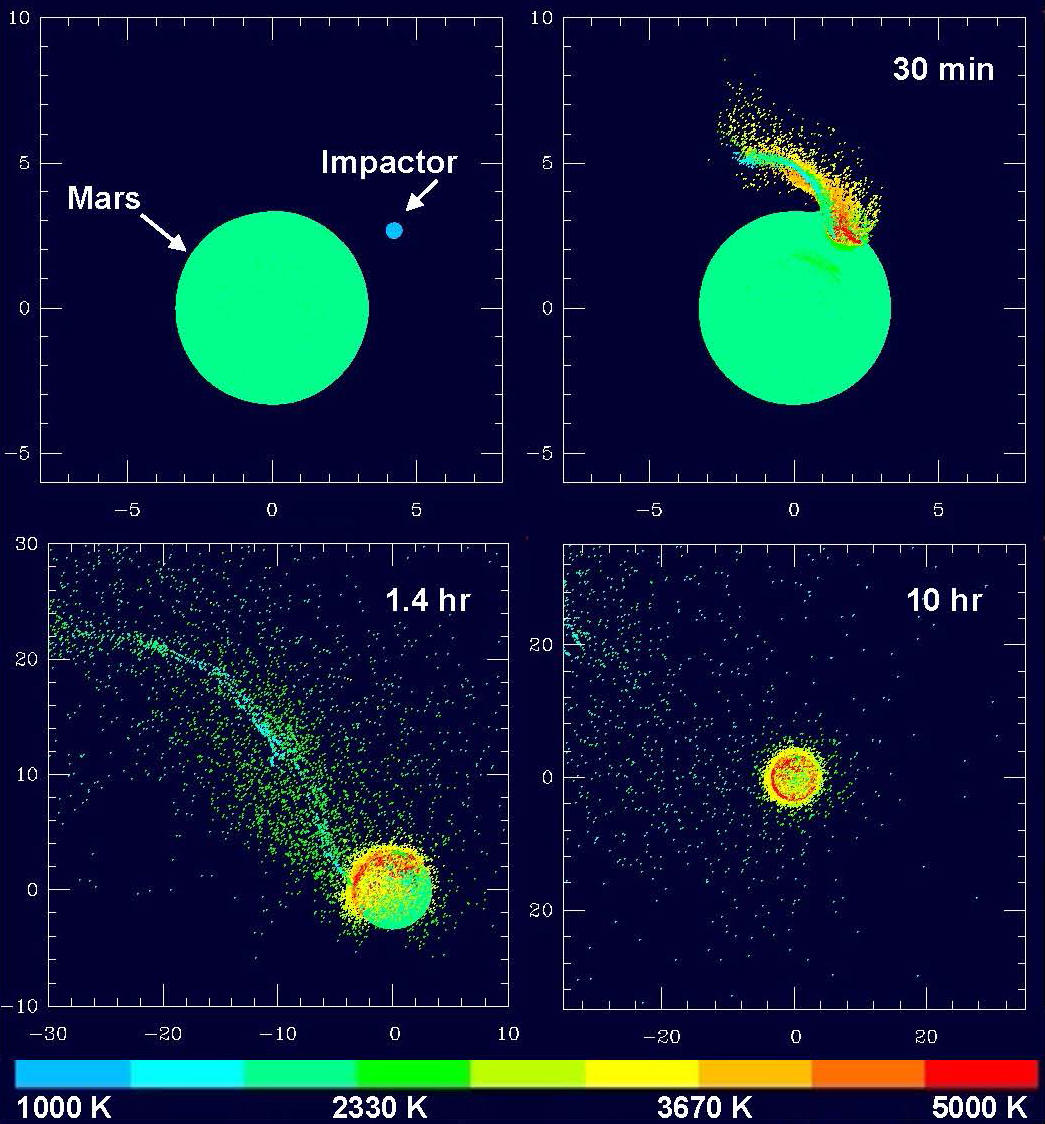Giant Impact May Have Created Mars' Moons

Mars may have gained its two tiny moons after an asteroid-size object slammed into the surface of the Red Planet. New models suggest that an object the size of the largest of the asteroid-belt inhabitants could have kicked up enough material to form Mars' two moons, Phobos and Deimos.
"Ours is the first self-consistent model to identify the type of impact needed to lead to the formation of Mars' two small moons," Robin Canup, a researcher and associate vice president at the Southwest Research Institute (SwRI), said in a statement. Canup is one of the leading scientists using large-scale simulations to model planet-scale collisions like the one thought to have formed Earth's own moon.
Scientists have debated the origins of the two Martian moons for decades. One model suggests that they may have been captured from the asteroid belt. Another suggests that they formed out of a disk of debris around the Red Planet. The fact that both moons have a nearly circular orbit around the equator makes a strong case for their birth by impact. [Moons of Mars: Amazing Photos of Phobos and Deimos]
Moons forming from the debris after a smashup isn't unheard of. Earth's moon is thought to have formed after a Mars-size object crashed into the planet 4.5 billion years ago. Earth's diameter is about 8,000 miles (12,875 kilometers). With a diameter of just over 2,100 miles (3,380 km), the moon is about a quarter of its parent planet's size.
Mars, on the other hand, is smaller than our planet, with a diameter of just over 4,200 miles (6,760 km). Phobos and Deimos are very small, with diameters of only 7.5 and 14 miles (12 and 22.5 km), respectively, and with very close-in orbits.
"A key result of the new work is the size of the impactor," or the body that collided with the planet, Canup said. "We find that a large impactor — similar in size to the largest asteroids, Vesta and Ceres — is needed, rather than a giant impactor."
Vesta is the second largest object in the asteroid belt, with a diameter of 329 miles (530 km). Ceres is the largest inhabitant of the asteroid belt, with a diameter of 584 miles (940 km) — it is large enough that it is classified as both an asteroid and a dwarf planet.
Get the Space.com Newsletter
Breaking space news, the latest updates on rocket launches, skywatching events and more!

The last of many
Phobos and Deimos were likely not the only moons created by the collision, according to the researchers' model. After the large impactor smashed into the planet, some of the debris formed a disk that flew up to circle the Martian equator.
"The outer portions of the disk accumulate into Phobos and Deimos, while the inner portions of the disk accumulate into large moons that eventually spiral inward and are assimilated into Mars," said Julien Salmon, a researcher at SwRI and second author on the paper.
Currently, Phobos is spiraling inward, and should crash into Mars in another 50 million years or so. Deimos will escape that fate, as it is slowly spiraling outward, away from the planet.
Previous simulations of impactors also created multiple moons, but their size meant that Phobos and Deimos wouldn't exist today.
"Larger impacts advocated in prior works produce massive disks and more massive inner moons that prevent the survival of tiny moons like Phobos and Deimos," Salmon said.
In addition to their existence, the new research also provided clues about what future missions might find when they visit Phobos and Deimos.
"The model also predicts that the two moons are derived primarily from material originating in Mars, so their bulk compositions should be similar to that of Mars for most elements," Canup said.
In 2024, the Japan Aerospace Exploration Agency (JAXA) plans to launch the Mars Moons eXploration (MMX) mission to visit the two Martian moons. MMX will land on the surface of Phobos and collect a sample to return to Earth in 2029.
"A primary objective of the MMX mission is to determine the origin of Mars' moons," Canup said.
"Having a model that predicts what the moons' composition would be if they formed by impact is a key constraint for achieving that goal."
Follow Nola Taylor Redd at @NolaTRedd, Facebook, or Google+. Follow us at @Spacedotcom, Facebook or Google+. Originally published on Space.com.
Join our Space Forums to keep talking space on the latest missions, night sky and more! And if you have a news tip, correction or comment, let us know at: community@space.com.

Nola Taylor Tillman is a contributing writer for Space.com. She loves all things space and astronomy-related, and enjoys the opportunity to learn more. She has a Bachelor’s degree in English and Astrophysics from Agnes Scott college and served as an intern at Sky & Telescope magazine. In her free time, she homeschools her four children. Follow her on Twitter at @NolaTRedd









